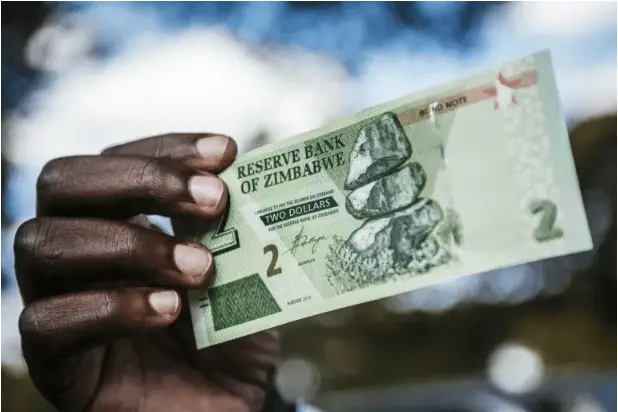Zimbabwe’s decades old inflation has been worsened by the Russia-Ukraine war. Inflation in Zimbabwe remains one of the highest globally and the only country in Southern Africa with headline inflation above 50 per cent.
Prior to the war, rising inflation in Zimbabwe, low foreign direct investments, unsustainable foreign debt levels and corruption were among a plethora of problems plaguing Zimbabwe’s economy.
Zimbabwe’s economic problems started surfacing in 1997 when the regime of the late Robert Mugabe paid unbudgeted pensions to veterans of the country’s 1970s liberation war, leading to a currency collapse. The situation got worse in 1999 when Zimbabwe sent its troops to fight in Democratic Republic of Congo civil war that also drew armies from Uganda, Rwanda and Angola. A violent land reform programme that displaced nearly 5,000 commercial farmers, precipitating the crisis. Disputed elections and human rights violations led to the country’s economic isolation, which has taken a serious toll on the economy.
Read: Miners in Zimbabwe to pay mining royalties in commodities
Inflation Effects in Zimbabwe
A 2022 report titled Impact of the Ukraine Crisis in Zimbabwe put together by World Food Programme (WFP), International Organization for Migration (IOM) and Food and Agriculture Organisation (FAO), outlines the effects of the war which include increasing food, fuel and fertiliser prices; disrupted supply chains and trade, leading to fiscal tightening; and a widening of inequalities and governance issues including general deterioration of macro-economic and living conditions. Poor households have further fallen into food insecurity emanating from the increased cost of living.
Fuel prices: Fuel prices were the first to be hit by the Russia-Ukraine crisis. Zimbabwe imports most of its fuel from Mozambique, South Africa and Singapore. The price of fuel experienced a sharp increase immediately after the start of the Ukraine crisis which has in turn triggered an increase in the price of basic food and non-food commodities across the country.
Input Prices: Prices of agricultural inputs, in particular fertiliser, were already on the rise by over 100 per cent before February 2022 and the Ukraine crisis further drove prices up due to the shortage created.
Zimbabwe uses around 800,000 tonnes of fertiliser a season with over 70 percent of the fertilisers used being imported as raw materials and or finished products thus exposing the market to the effects of global shortages and price volatility.
Household access to agricultural inputs remains limited as the 2022/23 main cropping season begins. There is a possibility of a delayed start of the rainy season in the primary crop-producing northern regions of the country which could further affect crop production.
Food prices: The food commodity that experienced the sharpest price increase was vegetable oil, as Zimbabwe is mainly dependent on imports. For instance, 96 per cent of its sunflower oil is imported. There is also reduced production among communal farmers occasioned by soaring inflation.
In addition, at least half of Zimbabwe’s wheat comes from Russia. But with wheat prices up nearly 15 per cent in early March from 119,000 Zimbabwe dollars ($595) to 136,544 Zimbabwe dollars ($682) per metric tonne, residents have to pay more for bread.
It is estimated that about one-thirds of Zimbabweans did not have enough food to eat in rural and urban areas between January and March 2022.
Remittances: The report indicated a decrease in the proportion of households receiving remittances. This could be attributed partially to the impact of the crisis in countries where remittances originate from. 90 per cent reported that remittances were not adequate to cover essential needs.
In summary, the agriculture industry is the hardest hit amid heightened food insecurity and rising cost of living. This has hampered development gains and hindered progress towards the Sustainable Development Goals (SDGs).
How Zimbabwe is coping with high inflation
The Government of Zimbabwe, in June, took immediate fiscal and monetary policy measures to stabilise the price of fuel, resulting in a reduction of the average cost by 10 per cent. However, the current price remains 18 per cent higher than it was during the pre-crisis period, increasing inflation in Zimbabwe.
Monica Mutsvangwa, Zimbabwe’s Minister of Information, Publicity and Broadcasting Services had earlier, in May, announced the mandatory blending of gas with ethanol produced locally. Petrol was blended with 20 per cent ethanol, which reduced the pump price by 7 cents.
The government said it will also embark on a $20 million upgrade of an oil pipeline from Mozambique’s port city of Beira to increase its capacity and reduce the inland country’s reliance on trucks to deliver fuel.
Among other measures that the government is rolling out to tackle inflation in Zimbabwe and stabilise the exchange rate include freezing payments to Government contractors accused of driving exchange rate volatility, raising interest rates to curb speculative borrowing and introducing gold coins as an alternative investment instrument while mopping up excess liquidity.
Specifically, the central bank hiked the bank policy rate from 80 per cent to 200 per cent.
The effects of these measures can be seen as inflation in the month of October is 3.2 per cent, down from 16.1 per cent in July 2022 when the measures were introduced.
However, many do not agree with some of the measures put in place arguing that the high interest rates are hurting business, reducing spending ability and declining aggregate demand.
In an interview with Herald, Economist Professor Gift Mugano hinted at the need for the government to find innovative ways of funding infrastructure projects like using diaspora bonds instead of using cash.
Also, Zimbabwe had already adopted and promoted a number of digital payment systems pre pandemic which included the Real-Time Gross Settlement (RTGS), Electronic Funds Transfer (EFT), mobile money, and electronic cards (both local and international).
The country saw a positive perception and shift towards digital transactions. This shift towards digital transactions reduced the demand for hard cash, which had been the norm during the hyper-inflationary era. The introduction of digital financial transactions in Zimbabwe has brought numerous transformational benefits as outlined in the article, Addressing Zimbabwe’s inflation: The role of the digitalization of financial transactions.
First, it saved the country from the burden of continuous money printing to meet demand, especially in such a hyperinflationary environment.
Second, it dramatically added to increased financial inclusion for marginalised citizens, particularly rural folks. Because informal businesses or startups struggle to access funding from normal banking services, the flourishing of products that enable digital financial transactions has somewhat increased access to the financial sector.
Third, to some extent, this financial digitization process also contributed to transformation and increased uptake of information and communications technologies in the country, including ramping up demand for internet services. In essence, the process created other economic opportunities through the creation of new and innovative businesses, generating employment opportunities in the process.
Also Read: List of Exchange Traded Funds on the Zimbabwe Stock Exchange
Inflationary complications for Zimbabwe
However, some of the measures are hard to implement due to Russia Zimbabwe ties which originate in the 1970s when Zimbabwe was struggling to gain independence from Britain. At the time Russia sent in weapons and trained the Zimbabwean army to fight.
Hence today, Russia has invested in the country, particularly in the mining and energy sectors. In an article by Aljazeera, economists fear that the slew of sanctions on Russia could have a ripple effect on African nations like Zimbabwe that have bilateral investment protection and promotional agreements with Russia.
Some of the investments that could be affected include one by fertiliser giant Uralchem, as well as a project to dig for platinum in what would be Zimbabwe’s biggest mine, 62km west of Harare and in which Russian tycoon Vitaliy Machitski has a 47.8 percent stake, he said. A 2019 agreement between state-owned Zimbabwe Consolidated Diamond Company and Russia’s Alrosa, the world’s largest producer of rough diamonds, to jointly explore for diamonds in Zimbabwe, will also be affected.




